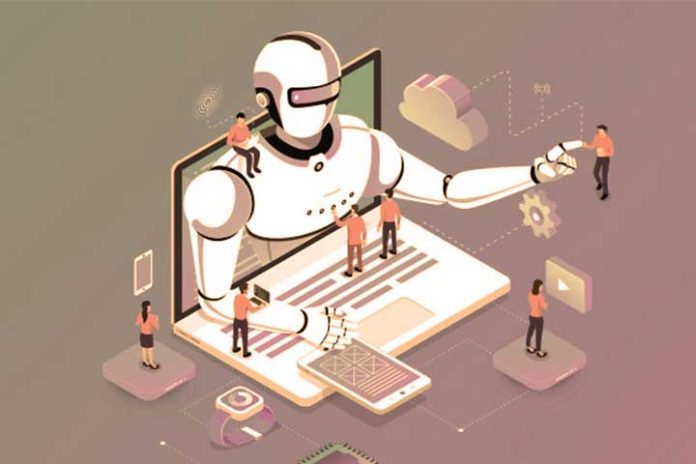Difficult to navigate in the vast field of activity that represents AI. Understanding what sets each of the new tools it brings together will help you integrate them into your organization as well as possible.
As tools incorporating artificial intelligence become more and more mainstream, many companies catch up when deploying these new systems in their infrastructure. And it is more than understandable: these tools are very varied, often misunderstood, and constantly evolving. To start making sense of the AI landscape and determining how your business will need to adapt, the first thing to understand is that the term “AI” actually covers a wide range of different things.
In a study presented in the forthcoming book “Artificial Intelligence for Sustainable Value Creation,” we analyzed how more than 800 different AI systems are used in 14 industries. Based on our analysis, we found that these systems can be classified into four distinct categories: techniques that perform routine tasks with limited ethical implications, those that perform everyday tasks with a moral component, those that serve tasks creatives with minor ethical consequences, and, finally, systems that require both creativity and ethical decision-making.
As you integrate these tools into your organization, understanding the distinctions between these different types of tasks supported by AI can help you find the most suitable tool for each mission and find the best match. Between this tool and your employees and, ultimately, to optimize collaboration between man and machine.
Routine tasks
The first category we identified is AI systems designed to perform repetitive tasks. These systems, including robotic arms for manufacturing and assembly, automated guided vehicles (AGVs) for product handling, or autonomous forklifts, are used for simple mechanical tasks in industrial environments such as factories. And warehouses. In this case, the role of the human is mainly to supervise the AI tool.
While these tools will render many traditional assembly jobs obsolete, the presence of human operators to oversee the proper conduct of these tasks will remain a necessity, which will place employees in new, more management-oriented roles. To prepare for this transition, companies must think about the best way to integrate their employees into new production processes and maintain the motivation of teams faced with these new responsibilities.
Simple tasks that require ethical decision making
Specific, very repetitive tasks nevertheless require a high level of ethical awareness, which makes the presence of humans in support of these AI systems particularly important. For example, when you work with robots that help addicted people feed themselves.
When companies implement this type of AI system, they must consider the ethical implications of any automated task and ensure that the tools deployed are accompanied by human employees trained to make moral decisions. Difficult when needed. For example, in the drug dispensing robot, it is essential to think about how best to automate informing patients and obtaining consent (and possibly including a human backup system). In support of automated communications).
Additionally, these tasks often benefit from human touch, even though humans don’t do much differently from the machine. For example, suppose you deploy a robot providing care to older adults in nursing homes. In that case, it is probably necessary that a caregiver accompany it on its rounds if only to improve the residents’ experience to whom it comes. Help.
Creative tasks with limited ethical components
This category of AI systems refers to applications in which AI is exploited for tasks requiring a high level of creativity and complexity but do not require a great deal of ethical awareness. For example, algorithms for predicting developments in financial markets must perform complex calculations to develop actionable results, but these processes generally do not have much of an ethical angle. Likewise, surgical robots can perform challenging tasks that sometimes require creative problem-solving, but they usually do not involve significant ethical considerations.
When implementing these systems, the potential for ethical issues is generally less. However, the stake for companies lies in the limits of their AI tools in terms of creativity and innovation. It can be helpful to create mechanisms that allow human operators to keep an eye on how tasks are performed and provide feedback when they come up with more efficient or innovative solutions.
Tasks with both creative and ethical elements
The last category we have identified concerns AI systems used for tasks requiring a high level of creativity and ethical decision-making. In this case, a machine must interact with its environment and perform a complex and honorable task with minimal or no human intervention. For example, fully autonomous vehicles (like Tesla’s or Google’s self-driving car projects) must perform complex and creative tasks while automating high-stakes ethical decisions, like prioritizing conflicting safety issues. Likewise, search and rescue robots used to find and evacuate people injured due to natural disasters must take advantage of their creative and ethical capacities to perform their tasks in safety and with respect for human dignity.
These systems have great potential in improving our lives, but they also require the most excellent control. Although significant progress has been made in developing automated tools capable of performing complex and ethical tasks, it is essential to ensure that human operators continue to exploit their creative and critical capacities in support of these. systems. Above all, it is necessary to be aware of the multiple dimensions of complexity that these systems address. This will allow humans to identify the required safeguards to control AI systems, especially when the latter must make decisions different from a traditional operator (whether it is an ethical or creative problem).
There is no simple answer to implementing AI in your business – and it will only get more complicated as these systems continue to evolve and develop. But, armed with this simple framework, you can begin to foster the human skills to grow within your teams to make the most of the wide range of AI tools at your disposal.

